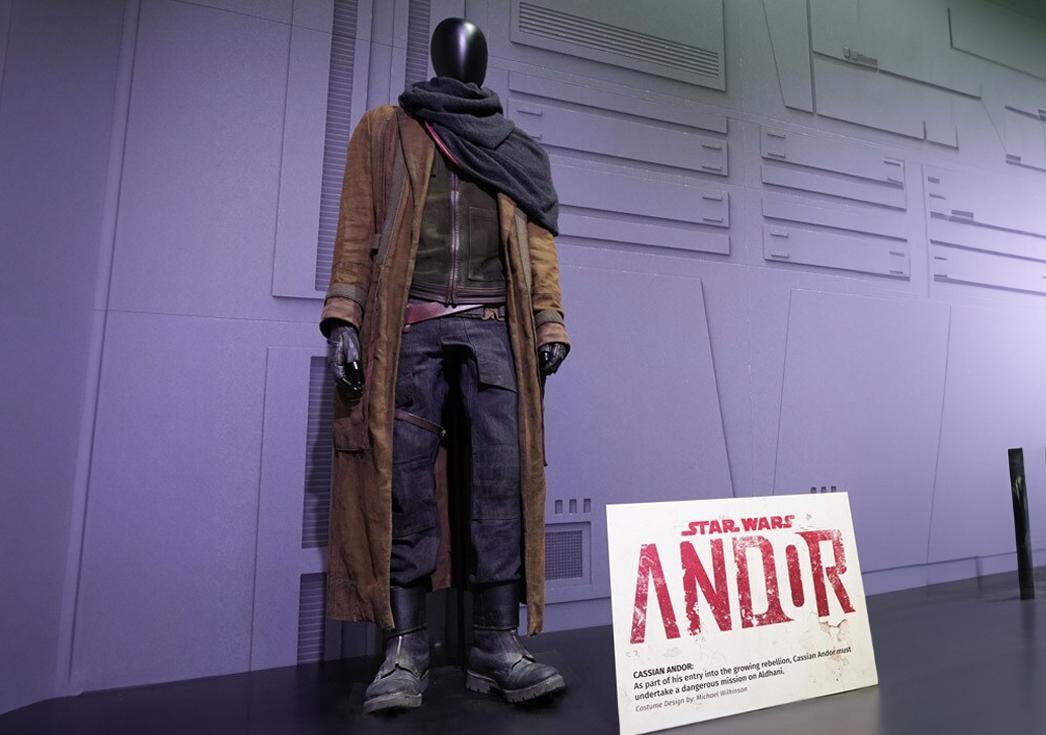
Andor’s Costume Design: Behind the “Seams” with E’s Executive
Editorial in conversation with C. Xenos, Creative Director of EverythingTM at E fashion marketplace app.
In film costume design transcends mere clothing; it’s a narrative tool, a character shaper, and a world builder. The “Andor” TV series — a cinematography Masterpiece, addition to the Star Wars universe, exemplifies this principle. As a creative, examining the sartorial choices in “Andor” reveals layers of storytelling, character nuances, and the series’ thematic resonance. This article delves into the creative genius behind these costumes, interpreting them through the lens of a fashion director.
The Essence of “Andor’s” Costume Design
“Andor” presents a unique visual narrative in the Star Wars saga, distinguished by its costume design led by Michael Wilkinson. Unlike its predecessors, “Andor” veers towards a grittier, more human-centric approach. The series’s aesthetic deviates from the traditional Star Wars palette, opting for a subdued, earthy tone that echoes the show’s mature and grounded narrative.
Wilkinson’s design philosophy pivots on practicality and realism, a departure from the often fantastical elements seen in the franchise. This choice not only grounds the characters in their environment but also allows for a more nuanced portrayal of their journeys. A notable example is the prison costumes for Narkina 5, which Wilkinson describes as the most challenging to create. These costumes were designed to feel disposable, made from a papery, strange fabric, symbolizing the expendability of the prisoners. The choice of a retro, vintage ’70s graphic down the arm, especially the pop of orange, serves a dual purpose. It makes the prisoners easily identifiable to the guards while subtly blending into the stark white walls of the prison, reflecting the show’s theme of oppression and resistance.
From a designer’s perspective, these choices are not just aesthetic but are deeply intertwined with the narrative, setting “Andor” apart in the realm of costume design.
Analyzing Key Costumes
The core of “Andor’s” visual storytelling lies in its character-specific costumes. Each outfit is meticulously crafted to reflect the character’s journey and the series’ broader socio-political landscape. For instance, Cassian Andor’s transformation from a scrappy thief to a Rebel spy is subtly mirrored in his evolving wardrobe. Early episodes show him in rugged, practical attire, blending with the downtrodden populace. As he becomes more involved with the Rebel cause, his attire shifts, becoming more structured, symbolizing his growing commitment and purpose.
The costume design for Mon Mothma, a pivotal character, is another testament to Wilkinson’s attention to detail. Her elegant, senatorial robes contrast sharply with the drab uniforms of the Empire, underscoring her status and her covert defiance. The robes’ rich textures and intricate embroidery hint at the complex layers of her character, her wealth, and her quiet rebellion.
Luthen Rael, a mysterious antiques dealer and Rebel leader, embodies the duality of his role through his clothing. His public persona is wrapped in sophistication and wealth, showcased through luxurious fabrics and classic designs. In contrast, his secret Rebel identity is cloaked in practical, nondescript clothing, a strategic choice for clandestine operations.
Interview analysis with the Costume Designer
In interviews, Wilkinson has emphasized the importance of authenticity in the “Andor” series. He and his team undertook extensive research to ensure that the costumes resonated with the series’ darker, more realistic tone. One of the significant challenges was creating a lived-in look that felt authentic to the Star Wars universe while also being unique to “Andor.” This involved aging processes, careful selection of fabrics, and consideration of how the costumes would interact with different environments.
Wilkinson’s dedication to creating costumes that are not only visually striking but also tell a story is evident. He believes that every stitch, every fabric choice, and every color plays a crucial role in building the world of “Andor” and enriching the characters’ narratives.
The Role of Costume in Storytelling
Costumes in “Andor” are not merely ornamental; they are integral to the storytelling. Each outfit serves as a visual cue, revealing insights into the characters’ states of mind, allegiances, and transformations. For instance, the utilitarian clothing of the Rebel fighters reflects their grassroots, improvised rebellion, contrasting with the uniformity and sterility of the Empire’s attire. This visual dichotomy enhances the narrative’s tension and highlights the ideological clash between freedom and control. Wilkinson’s adept use of costume design to convey subtext and thematic elements elevates “Andor” beyond a typical sci-fi saga, grounding it in a more relatable, human experience.
Trends and Influences in Contemporary Costume Design
“Andor” is a prime example of the evolving landscape of costume design in cinematography. Modern designers are increasingly focusing on realism, character development, and thematic consistency. Wilkinson’s approach in “Andor” aligns with these trends, balancing the fantastical elements of the Star Wars universe with a more grounded, realistic aesthetic. This shift mirrors a broader trend in the industry, where costume design is becoming a more prominent tool in storytelling, moving beyond mere aesthetic appeal to become an essential narrative device.
In “Andor,” costumes are a language, speaking volumes about the characters and the world they inhabit. Wilkinson’s work on the series is a masterclass in how costume design can be seamlessly integrated into storytelling, enhancing both character development and thematic depth. From an arts perspective, “Andor” not only sets a new standard in costume design but also reflects the evolving role of fashion in narrative media. It stands as a testament to the power of costume design as an indispensable tool in the art of visual storytelling.



